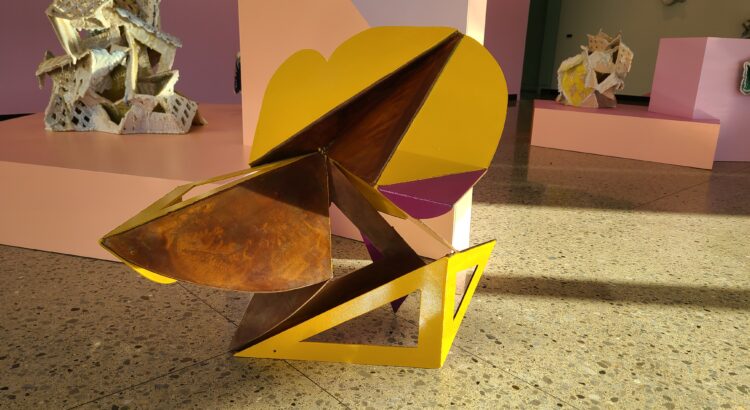2:00pm • Saturday, January 14, 2023 • UMMA
This Saturday, I visited the UMMA to take a closer look at YehRim Lee’s current installation, Dopamine Dressing. According to the exhibition’s description, Lee was inspired by chromotherapy and the “dopamine dressing” trend of 2020, in which individuals dressed in bright colors and bold textures as a way to boost their mood. In Dopamine Dressing, Lee explores the possibility of chemically altering the viewer’s brain using different visual stimuli to produce feelings of happiness.
 For me, when I initially saw Lee’s art in the window of the UMMA over the course of its installation, my reaction was negative. In passing, they looked haphazardly constructed, some appearing to collapse in on themselves under the weight of their many layers of sickly pastel glaze. During my time with the sculptures on Saturday, however, I had the opportunity to see how each piece was, in fact, meticulously crafted with different patterns and techniques reoccurring throughout the collection. Lee’s repeated use of patterns like grids, scallops, and interlocking circles, mostly carved into either triangular or semicircular slabs of clay, solidified an overarching theme for the exhibition. Certain glazing techniques also repeat, with some sculptures appearing as though thick glaze was applied with a piping bag, others as if the edges of the sculptures were repeatedly dipped in different glazes. In many places, glaze oozes down the sides of the ceramics, looking like massive, sugary dollops of frosting.
For me, when I initially saw Lee’s art in the window of the UMMA over the course of its installation, my reaction was negative. In passing, they looked haphazardly constructed, some appearing to collapse in on themselves under the weight of their many layers of sickly pastel glaze. During my time with the sculptures on Saturday, however, I had the opportunity to see how each piece was, in fact, meticulously crafted with different patterns and techniques reoccurring throughout the collection. Lee’s repeated use of patterns like grids, scallops, and interlocking circles, mostly carved into either triangular or semicircular slabs of clay, solidified an overarching theme for the exhibition. Certain glazing techniques also repeat, with some sculptures appearing as though thick glaze was applied with a piping bag, others as if the edges of the sculptures were repeatedly dipped in different glazes. In many places, glaze oozes down the sides of the ceramics, looking like massive, sugary dollops of frosting.


The effect was visual decadence. While the inspiration for the installation may have been fashion, the sculptures heaped with pastel-colored glazes brought to mind cakes piled high with buttercream. There was a sense of maximalism: on top of the already complex structures and their glazing, some featured gold leaf, or iridescent patches that mimicked mother-of-pearl. For me, the gallery somehow elicited a kind of greediness, the feeling I get when I’m shopping and walk past piles of fast fashion clothing and I have force myself not to buy everything I lay eyes on. In this sense, I connect with Lee’s intention for the work. In some notes on the exhibition, Lee writes that the technique she used in firing and re-firing the sculptures almost to collapse connects with the fleeting nature of the bursts of dopamine we experience while taking in the artwork. Similarly, the culture of waste inherent in the fashion industry from which Lee took inspiration offers us only momentary happiness.















